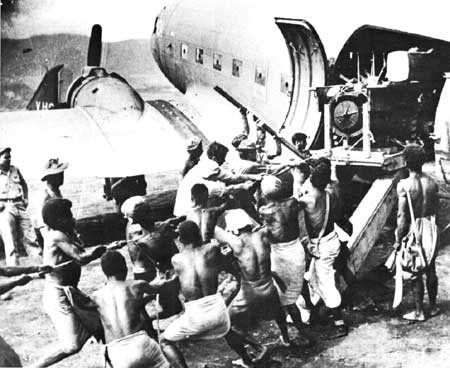| The War in the Pacific |
|
|
PACIFIC ENCOUNTERS: TECHNOLOGY
The encounter with the full brunt of Western and Japanese technological might astonished Islanders who had little previous experience with the output of modern industrial nations. The sudden infusion of the machinery of war and the modes of production required to support it left deep impressions on islands where prestige had traditionally been measured in terms of ability to produce and distribute food and wealth. Weaponry Islanders had a front row seat for the most awesome display of firepower ever let loose in war. Islands which had only known copra boats and occasional seaplanes now witnessed regular armadas of warships and bombers. Beaches and lagoons where only canoes had passed were now host to huge transports capable of landing tanks, trucks and enough supplies to fill up whole warehouses. Cargo The term "cargo" once referred to Western goods stored in the holds of trading ships. It was given new meaning by the Pacific war. Between 1942 and 1945, the U.S. Army alone shipped over four million tons of supplies to the Pacific. To a large extent, it was Pacific Islanders who loaded and unloaded this cargo. Base "Cities" Military supply lines did more than transport materiel from one point to another. Modern support facilities and industrialized forms of production were also introduced. In areas where only coconut plantations had stood before, hundreds of miles of roads, docks and airfields were laid down, electricity and telephone lines strung, acres of warehouse and fuel tank space constructed, and row after row of quonset huts put up. Whole cities appeared in a matter of months, with the latest Hollywood (or Tokyo) attractions showing nightly for service personnel and Islanders alike. Modes of Production These bases also became centers of production capable of supplying food and war materiel. The Japanese methods of intensive gardening and Allied war farms introduced new ideas about agricultural production. Islanders found employment in new factories, machine shops, print shops and medical clinics. An ordinance plant at the Allied base at Milne Bay, Papua New Guinea acquired the name "Little Detroit" for its ability to assemble 120 vehicles a day. A boat assembly plant at the same base constructed a total of 2,000 landing craft. People on islands where there had been no roads learned how to drive trucks, tractors, jeeps and motorcycles; and they learned how to fix them in motor pool repair shops.
Excess American industrial output exceeded the needs of troops to such an extent that U.S. troops nonchalantly gave away huge amounts of food, clothing and equipment. Islanders working at major supply bases at the war's end witnessed the spectacle of thousands of tons of machinery being abandoned or destroyed, producing such current tourist attractions as Espiritu Santo's "million dollar point" where vehicles and equipment were pushed, rolled or dumped into the sea. At Kukum docks on Guadalcanal, the U.S. Army burned, buried or dumped at sea some 60,000 tons of cargo worth almost $20,000,000 at the end of the war. |
